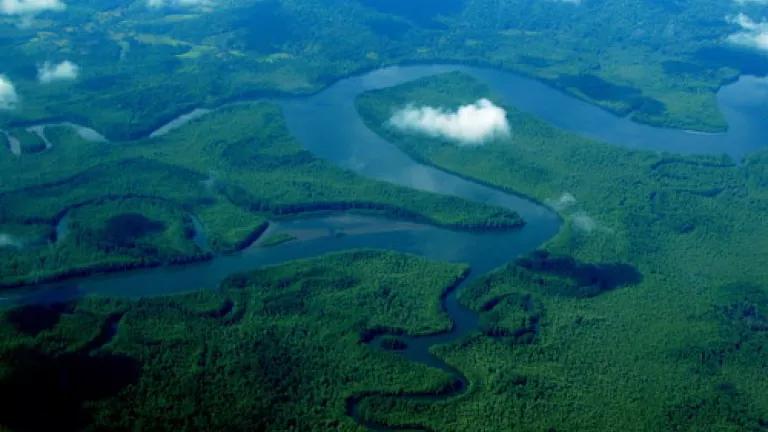Major international airport could open up Costa Rica's Osa Peninsula to unsustainable tourism

Supporters of a controversial international airport proposed near Costa Rica’s Osa Peninsula recently defended their project before the Legislative Assembly’s Environmental Commission. According to the Costa Rican civil aviation agency, the airport would incorporate technologies and practices that would make it the country’s first “green” airport. However, there remain serious concerns about what the construction and operation of a major airport would mean for the fragile Térraba-Sierpe National Wetland nearby and the overall Osa region, one of the most biologically diverse places left in the world. Costa Rica only has to look at rampant overdevelopment along the northern Pacific Coast to see how a busy international airport near fragile lands, coupled with weak controls, can negatively affect coastal resources and communities. The forests and wetlands of the Osa are the greatest value for the region and its people and any new development should protect and sustain these ecological values rather than undermining them.
Photo credit: NRDC
Wetlands and coastal land under threat. Costa Rica’s current plan is to construct a new international airport less than three miles from the Térraba-Sierpe Wetland, a Ramsar Wetland of International Importance that includes one of Central America’s most important mangrove forests. Described by some as “Costa Rica’s Everglades”, the winding waterways of this region are home to an abundance of bird, mammal, reptile and aquatic species. But these wetlands do much more than provide critical habitat for wildlife, they also play an important role in erosion control, water purification and as fish and shellfish nurseries. The mangrove forests in the Térraba-Sierpe are also critical for storing carbon. A study on mangroves by a team at the US Forest Service found that coastal mangroves store more carbon than nearly any other forest on Earth – up to four times more per hectare than other tropical forests. These findings indicate that protecting coastal mangroves – such as the ones in the Térraba-Sierpe– is a critical component in the fight against climate change. The Térraba-Sierpe Wetlands are so important ecologically – and economically – for Costa Rica that a study prepared for the University of Vermont estimates that the wetlands provide ecosystem services valued at between $300,000,000 to nearly $2,000,000,000.
Unfortunately, this region is already threatened by environmentally unsustainable activities. Industrial agriculture, weak management, and hydroelectric development are all placing pressure on the wetlands. Rampant real-estate development for tourism is also a looming threat. The coastal lands along Osa’s Fila Costeña are already fraught with erosion and water problems due to uncontrolled development. Just between 2008 and 2009 Costa Rica’s Environmental Tribunal identified 65 environmental infractions by developers along the coast. Some illegal construction sites have also been found within the boundaries of the wetlands. A major airport in the region could lead to further uncontrolled real-estate development, harming nearby fragile ecosystem and communities.
A chance to learn from experience. Costa Rica already has one example of a major international airport leading to uncontrolled and environmentally unsustainable tourism and vacation home development. In the northern Costa Rican province of Guanacaste, construction of an international airport in Liberia led to a flood of poorly-planned tourism expansion. The results are sobering: degradation of coastal areas, inadequate sanitary infrastructure, and local communities who find their access to fresh water drying up when it’s diverted to other uses such as golf courses in mega-resorts. This is not what the Osa and its communities need. After an exhaustive two year study that looked at the impact of tourism along Costa Rica’s Pacific Coast, the Center for Responsible Travel (CREST) issued a report that recommended that a major international airport in southern Costa Rica was not advisable.
There are many lessons to learn from Guanacaste about the negative impact of a major international airport near fragile lands. Yet despite strong indications that the proposed airport may not be the best option for the Osa, the government is moving forward with its plans. Costa Rican President Laura Chinchilla even declared the proposed airport a national interest project. This type of declaration simply makes no sense without a full evaluation of the impact such a major development could have on the surrounding region and without appropriate land-use plans in place. Costa Rica must also take full stock of the value of preserving the Osa’s ecosystems before moving forward with plans for a major development that could wreak havoc on the region’s biodiversity and communities.
Protecting biodiversity and sustaining livelihoods. Solutions must be found that ensure that conservation in the Osa goes hand in hand – and in fact helps create – environmentally sustainable livelihoods for local communities. During a recent visit to the Osa I met local residents who were working to find these solutions –farmers committed to environmentally sustainable practices, small-entrepreneurs running family-owned eco-lodges highlighting the region’s culture and traditions and artisanal fishermen committed to conserving the Osa’s forests, mangroves, coasts and wildlife. Making sure these individuals are successful in their efforts should be what President Chinchilla declares in the national interest – not a major airport that could open up the region to rampant overdevelopment.

